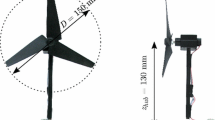Abstract
When designing new wind farms, one has to rely on models describing the flow field around and inside the farm, since direct numerical simulation is far too computationally expensive. In order to develop better models for power prediction of wind farms, knowledge about the flow field around turbines, the stability of the wakes and the interaction between them is essential. Since the conditions during field measurements are difficult to control, wind tunnel measurements play an important role when studying wakes behind wind turbines. Within the present work, an experimental methodology has been developed to study the evolution and stability of the tip vortices shed from the rotor blades of a small-scale turbine model. The stability of the tip vortices was studied by introducing a periodic disturbance to the flow, which is shown to have a clear effect on the development of the vortices. Prior to the vortex breakdown, clear signs of vortex pairing were also observed. A parameter study was performed by varying the amplitude and frequency of the forced disturbance, and the effect on the tip vortices was evaluated. This experiment is one of the first where the influence of a periodic disturbance on a wind turbine wake is studied, something that previously has been performed in a number of numerical studies.





















Similar content being viewed by others
References
Adaramola MS, Krogstad P (2011) Experimental investigation of wake effects on wind turbine performance. Renew Energy 36:2078–2086
Alfredsson PH, Dahlberg J (1979) A preliminary wind tunnel study of windmill wake dispersion in various flow conditions. Technical report, FFA Flygtekniska Försöksanstalt
Barthelmie RJ, Frandsen ST, Nielsen MN (2007) Modelling and measurements of power losses and turbulence intensity in wind turbine wakes at middelgrunden offshore wind farm. Wind Energy 10:517–528
Bingöl F, Mann J, Larsen GC (2010) Light detection and ranging measurements of wake dynamics. Part 1: one-dimensional scanning. Wind Energy 13:51–61
Bruun HH (1995) Hot-wire anemometry: principles and signal analysis. Oxford University Press, Oxford
Burton RJ, Sharpe D, Jenkins N, Bossanyi E (2001) Wind energy handbook. Wiley, New Jersy
Cal RB, Lebrón J, Castillo L, Kang HS, Meneveau C (2010) Experimental study of the horizontally averaged flow structure in a model wind turienarray boundary layer. J Renew Sustain Energy 2:013,106
Chamorro LP, Porté-Agel F (2009) A wind-tunnel investigation of wind-turbine wakes: boundary-layer turbulence effects. Bound-Layer Meteorol 132:129–149
Dobrev I, Maalouf B, Troldborg N, Massouh F (2008) Investigation of the wind turbine vortex structure. 14th International symposium on applications of laser techniques to fluid mechanics, Lisbon, Portugal, July 7–10
Ebert PR, Wood DH (2002) The near wake of a model horizontal-axis wind turbine at runaway. Renew Energy 25:41–54
Glauert H (1935) Airplane propellers in aerodynamic theory, ed. Springer
Grant I, Parkin P (2000) A DPIV study of the trailing vortex elements from the blades of a horizontal axis wind turbine in yaw. Exp Fluids 28:368–376
Grant I, Mo M, Pan X, Parkin P, Powell J, Reinecke H, Shuang K, Coton F, Lee D (2000) An experimental and numerical study of the vortex filaments in the wake of an operational, horizontal-axis, wind turbine. J Wind Eng Ind Aerodyn 85:177–189
Hansen MOL (2010) Aerodynamics of wind turbines. Earthscan, UK
Hu H, Yang Z, Sarkar P (2012) Dynamic wind loads and wake characteristics of a wind turbine model in an atmospheric boundary layer wind. Exp Fluids 52:1277–1294
Ivanell S, Mikkelsen R, Sørensen JN, Henningson D (2010) Stability analysis of the tip vortices of a wind turbines. Wind Energy 13:705–715
Lindgren B (2002) Flow facility design and experimental studies on wall-bounded turbulent shear-flows. Ph.D. thesis, KTH Royal Institute of Technology
Medici D, Alfredsson PH (2006) Measurements on a wind turbine wake: 3D effects and bluff body vortex shedding. Wind Energy 9:219–236
Medici D, Alfredsson PH (2008) Measurements behind model wind turbines: further evidence of wake meandering. Wind Energy 11:211–217
Okulov VL, Sørensen JN (2007) Stability of helical tip vortices in a rotor far wake. J Fluid Mech 576:1–25
Örlü R (2006) Experimental study of passive scalar mixing in swirling jet flows. Licentiate Thesis, KTH Royal Institute of Technology
Sherry M, Sheridan J, Lo Jacono D (2010) Horizontal axis wind turbine tip and root vortex measurements. 15th International symposium on applications of laser techniques to fluid mechanics, Lisbon, Portugal, July 5–8
Trujillo J, Bingöl F, Larsen GC, Mann J, Kuhn M (2011) Ligt detection and ranging measurements of wake dynamics. Part 2: two-dimensional scanning. Wind Energy 14:61–75
Vermeer LJ, Sørensen JN, Crespo A (2003) Wind turbine wake aerodynamics. Prog Aerosp Sci 39:467–510
Wagner S, Barcis R, Guidati G (1996) Wind turbine noise. Springer
Walther JH, Guénot M, Machefaux E, Rasmussen JT, Chatelain P, Okulov VL, Sørensen JN (2007) A numerical study of the stability of helical vortices using vortex methods. J Phys: Conf Ser 75:012034
Wilson RE (1994) Aerodynamic behaviour of wind turbines. In: Spera DA (eds) Wind turbine technology: fundamental concepts of wind turbine engineering, ASME Press, USA, pp 215–282
Yang Z, Sarkar P, Hu H (2012) Visualization of the tip vortices in a wind turbine wake. J Vis 15:39–44
Zhang W, Markfort CD, Porté-Agel F (2012) Near-wake flow structure downwind of a wind turbine in a turbulent boundary layer. Exp Fluids 52(5):1219–1235
Acknowledgments
This work is part of the Nordic consortium for optimization and control of wind power farms and was financed by the Swedish Energy Agency. The turbine blades were designed with the help of Dr. Robert Mikkelsen and manufactured in the workshop at Technical University of Denmark. The turbine model support, strain gauge, generator and electrical equipment were provided by Jan-Å ke Dahlberg. Dr. Antonio Segalini is gratefully acknowledged for his valuable comments on the manuscript.
Author information
Authors and Affiliations
Corresponding author
Rights and permissions
About this article
Cite this article
Odemark, Y., Fransson, J.H.M. The stability and development of tip and root vortices behind a model wind turbine. Exp Fluids 54, 1591 (2013). https://doi.org/10.1007/s00348-013-1591-6
Received:
Accepted:
Published:
DOI: https://doi.org/10.1007/s00348-013-1591-6




